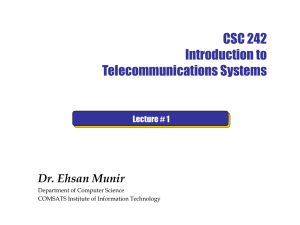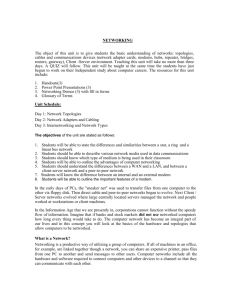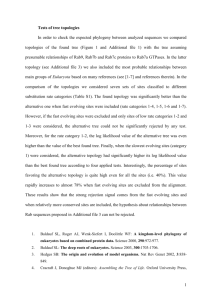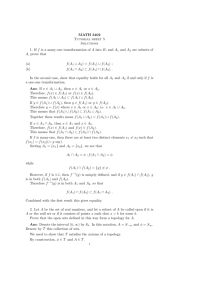A Study And Analysis on Computer Network Topology
advertisement
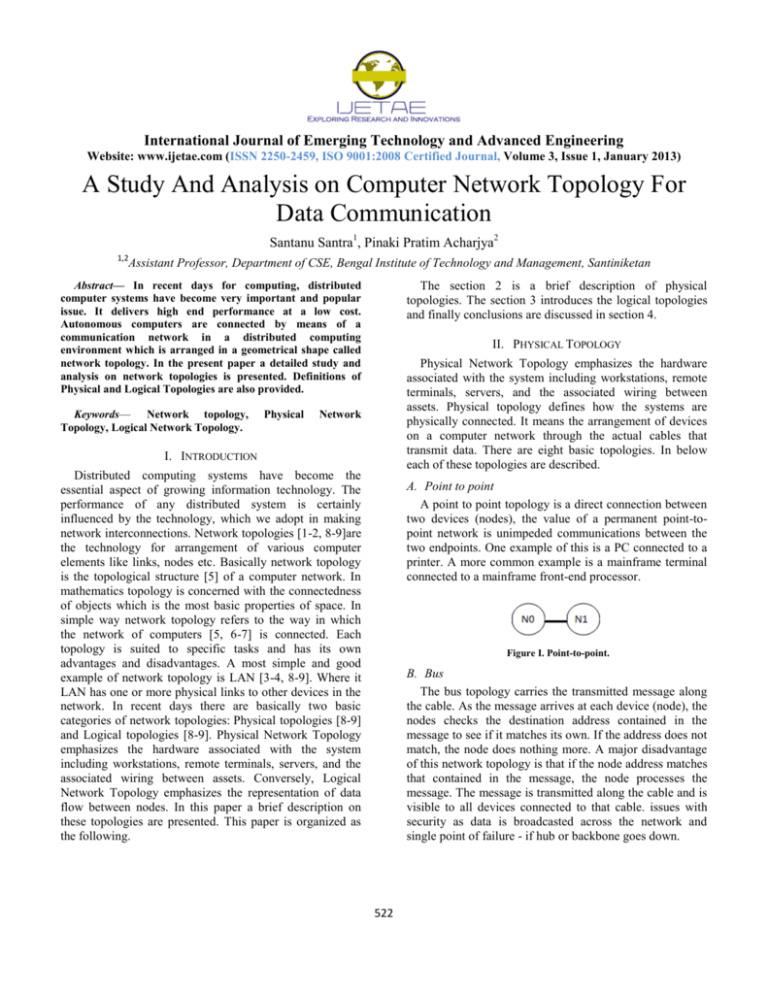
International Journal of Emerging Technology and Advanced Engineering Website: www.ijetae.com (ISSN 2250-2459, ISO 9001:2008 Certified Journal, Volume 3, Issue 1, January 2013) A Study And Analysis on Computer Network Topology For Data Communication Santanu Santra1, Pinaki Pratim Acharjya2 1,2 Assistant Professor, Department of CSE, Bengal Institute of Technology and Management, Santiniketan The section 2 is a brief description of physical topologies. The section 3 introduces the logical topologies and finally conclusions are discussed in section 4. Abstract— In recent days for computing, distributed computer systems have become very important and popular issue. It delivers high end performance at a low cost. Autonomous computers are connected by means of a communication network in a distributed computing environment which is arranged in a geometrical shape called network topology. In the present paper a detailed study and analysis on network topologies is presented. Definitions of Physical and Logical Topologies are also provided. Keywords— Network topology, Topology, Logical Network Topology. Physical II. PHYSICAL TOPOLOGY Physical Network Topology emphasizes the hardware associated with the system including workstations, remote terminals, servers, and the associated wiring between assets. Physical topology defines how the systems are physically connected. It means the arrangement of devices on a computer network through the actual cables that transmit data. There are eight basic topologies. In below each of these topologies are described. Network I. INTRODUCTION Distributed computing systems have become the essential aspect of growing information technology. The performance of any distributed system is certainly influenced by the technology, which we adopt in making network interconnections. Network topologies [1-2, 8-9]are the technology for arrangement of various computer elements like links, nodes etc. Basically network topology is the topological structure [5] of a computer network. In mathematics topology is concerned with the connectedness of objects which is the most basic properties of space. In simple way network topology refers to the way in which the network of computers [5, 6-7] is connected. Each topology is suited to specific tasks and has its own advantages and disadvantages. A most simple and good example of network topology is LAN [3-4, 8-9]. Where it LAN has one or more physical links to other devices in the network. In recent days there are basically two basic categories of network topologies: Physical topologies [8-9] and Logical topologies [8-9]. Physical Network Topology emphasizes the hardware associated with the system including workstations, remote terminals, servers, and the associated wiring between assets. Conversely, Logical Network Topology emphasizes the representation of data flow between nodes. In this paper a brief description on these topologies are presented. This paper is organized as the following. A. Point to point A point to point topology is a direct connection between two devices (nodes), the value of a permanent point-topoint network is unimpeded communications between the two endpoints. One example of this is a PC connected to a printer. A more common example is a mainframe terminal connected to a mainframe front-end processor. Figure I. Point-to-point. B. Bus The bus topology carries the transmitted message along the cable. As the message arrives at each device (node), the nodes checks the destination address contained in the message to see if it matches its own. If the address does not match, the node does nothing more. A major disadvantage of this network topology is that if the node address matches that contained in the message, the node processes the message. The message is transmitted along the cable and is visible to all devices connected to that cable. issues with security as data is broadcasted across the network and single point of failure - if hub or backbone goes down. 522 International Journal of Emerging Technology and Advanced Engineering Website: www.ijetae.com (ISSN 2250-2459, ISO 9001:2008 Certified Journal, Volume 3, Issue 1, January 2013) E. Mesh In this type of topology each device is interconnected with one another, allowing for most transmissions to be distributed even if one of the connections goes down. A major disadvantage is high chances of redundancy in many of the network connections and overall cost is too high compared to any other network topology. Figure II. Bus Topology C. Star Star topology is one of the most common network setups where each of the devices or nodes on a network connects to a central hub. A major disadvantage of this network topology is that if the central hub fails, all computers connected to that hub would be disconnected. A major disadvantage of this network topology is high dependence of the system on the functioning of the central hub. Failure of the central hub renders the network inoperable. Figure V. Mesh Network F. Tree Tree Structure suits best when the network is widely spread and vastly divided into many branches. Tree topology is a combination of two or more bus and the Star Topology connected together. Each star network is a local area network (LAN) in which there is a central computer or server to which all the connected nodes directly linked. The central computers of the star networks are connected to a main cable called the bus. A major disadvantage is the length of the network depends on the type of cable that is being used and tree topology network is entirely dependent on the trunk which is the main backbone of the network. If that has to fail then the entire network would fail. Figure III. Star Topology D. Ring In a ring topology all of the nodes or devices are connected to one another in a circle. The data passes from one device to the next one and all the way around the ring layout until it reaches the destination node. A major disadvantage is that if a single device is switched off, the network does not work. Figure VI. Tree Figure IV. Ring Topology 523 International Journal of Emerging Technology and Advanced Engineering Website: www.ijetae.com (ISSN 2250-2459, ISO 9001:2008 Certified Journal, Volume 3, Issue 1, January 2013) G. Hybrid Hybrid topology is a network topology that is composed of one or more interconnections of two or more networks that are based upon different physical topologies or a type of network topology that is composed of one or more interconnections of two or more networks that are based upon the same physical topology, but where the physical topology of the network resulting from such an interconnection does not meet the definition of the original physical topology of the interconnected networks. A major disadvantage is typically more expensive than other networks since it exploits the features of its component topologies. It requires more cabling between its hardware devices than other types of network topologies. Hybrid networks are difficult to set up and troubleshoot. Figure VIII. Daisy Chain Topology. III. LOGICAL TOPOLOGY Logical Network Topology emphasizes the representation of data flow between nodes. It means logical topology is associated with the arrangement of devices on a computer network and how they communicate with one another. The main role of logical topology is to communicate across the physical topologies among different systems. There are two categories of logical topologies: Shared media topology and token-based topology. A. Shared Media Topology In shared media topology the systems have unrestricted access to the physical media that is all the systems in a network have the ability to access the physical layout whenever they need it. Collision is the main disadvantage of this topology as more than one system send information out on the wire at the same time, the packets collide and as a result this collision kills the packets. Ethernet is an example of a shared media topology. As a remedy some huge networks are broken down into smaller networks. Some ethernet uses Carrier Sense Multiple Access protocol to reduce the number of collisions. Recommended font sizes are shown in Table 1. Figure VII. Hybrid Topology. H. Daisy Chain A daisy-chained network topology is all of your devices are connected in a chain- like or ring fashion. The master controller connects to a slave device, which in turn connects to another slave device, which connects to another slave device, and so on, and so on. If the ring breaks at a particular link then the transmission can be sent via the reverse path thereby ensuring that all nodes are always connected in the case of a single failure. A major disadvantage is a component failure or cable failure in midstream will disable the entire network and if you want to add a device in the middle of the chain or ring, the network will get down during the process. The cabling for these networks is generally put in open space and may therefore be more vulnerable to accidental disconnections and breaks. B. Token Based Topology In token based topology a token is used which travels around the network to access the physical media. If any node wants to send a packet to another one it should wait for the token which is traverse within the network either clockwise or anti-clockwise direction. 524 International Journal of Emerging Technology and Advanced Engineering Website: www.ijetae.com (ISSN 2250-2459, ISO 9001:2008 Certified Journal, Volume 3, Issue 1, January 2013) [3] After getting the token a node can send the packet towards the network and all the nodes within the path from sender node to destination node, and all the intermediate nodes should check the destination address, if it matches to anyone it should accept the packet and generate an acknowledgement packet. Acknowledgement packet should follow the reverse path to acknowledge the sender node that the packet is received by the destination node. [4] [5] [6] IV. CONCLUSION In this paper, performance of different kinds of topologies is considered and studied. Description of some inherent advantages and disadvantages computer network topologies to any system under study also has been described in this paper. This paper has provided some knowledge of analysis approaches for dealing with network topology related problems. The techniques covered in this discussion can be adapted to related computer network applications. This research work can also be extended further. [7] [8] [9] REFERENCES [1] [2] Banerjee, S., Jain, V., Shah, S., "Regular multihop logical topologies for lightwave networks", Communications Surveys & Tutorials, IEEE, On page(s): 2 - 18 Volume: 2, Issue: 1, First Quarter 1999. Cem Ersoy, Shivendra PanWar "Topological Design of Interconnected LAN-MAN Networks", IEEE INFOCO, pp. 22602269, 1992. 525 F. Backes, ―Transparent Bridges for Interconnection of IEEE 802 LANs,‖ IEEE Network, pp. 5-9, January 1988. Li Chiou Chen "The Impact of Countermeasure Propagation on the Prevalence of Computer Viruses" IEEE Transactions on Systems, MAN, and Cybernetics PartB; Cybernetics Volume 34, Number 2, pp. 823-833, April 2004. Geon Yoon, Dae Hyun Kwan, Soon Chang Kwon, Yong Oon Park, Young Joon Lee "Ring Topology-based Redundency Ethernet for Industrial Network" SICE-ICASE International Joint Conference, pp. 1404 – 1407, 18-21 Oct. 2006. Nicholas F. Maxemchuk, Ram Krishnan "A Comparison of Linear and Mesh Technologies---DQDB and Manhattan Street Network" IEEE Journal on Selected Areas in Communications, Volume 11, Number 8, October 1993. Bannister, J.A., Fratta, L., Gerla, M., "Topological design of the wavelength-division optical network", INFOCOM, Ninth Annual Joint Conference of the IEEE Computer and Communication Societies. The Multiple Facets of Integration. Proceedings, IEEE, On page(s): 1005 - 1013 vol.3, 1990. C. M. Harris, Fundamentals of Queueing Theory, Wiley Series in Probability and Statistics, John Wiley & Sons, Hoboken, NJ, USA, 4th edition, 2008. D. Bertsekas and R. Gallager, Data Networks, 2nd ed. Englewood Cliffs,.NJ: Prentice-Hall, 1992.




